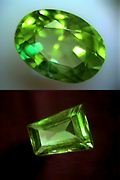![]()
Name:
Peridot (Olivine)

Chem:
Mg2SiO4-forsterite
(Mg, Fe)2SiO4
- olivine (Peridot)
Fe2SiO4
- fayalite
Crystal:
Orthorhombic (Usually glassy rounded grains, crystals are rare.)
Color:
light green, dark green, olive green, yellow-brown, and rarely reddish
Refrac. Index:
1.65-1.69
Birefraction:
0.036
Hardness:
6.5- 7
Spec. Grav.:
3.27 - 3.37
Fracture:
brittle
Cleavage:
imperfect
Environment:
a rock forming mineral and often present in basalt and volcanic ejecti.
Association:
basalt, gabbro and peridotite
Locals:
| St. Johns Island | Ar., N. M., USA | Burma | Australia | Norway |
Misc:
it is soluble very slowly in hydrochloric acid yielding a gel. Most of the gem variety is predominantly foresterite, named for the German naturalist, Johnn Forester.
Gem info:
Peridot has been mined on St. John's Island (known in Arabic as Zibergit) for more than 3000 years. At one time it was known as Topazion and the gem was topazos. Now the name topaz is given to an entirely non-related gem. Peridot may be from the Arabic, "faridat" which means gem.
It is also known as chrysolite from the ancients "chrysolithos", meaning "golden stone". It has an oily look which looks something like olive oil. Good crystals are more valuable than cut stones, so are usually purchased by mineral collectors. Small cut stones are very common (less than 2-3 carats) and not expensive. Stones over 5 carats begin to climb in value, and those above 10-15 carats my be pricey as they are rare.
![]()
oval
![]()
rectangle